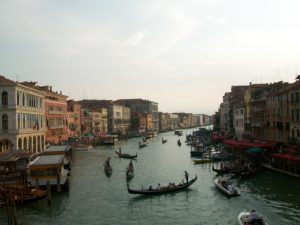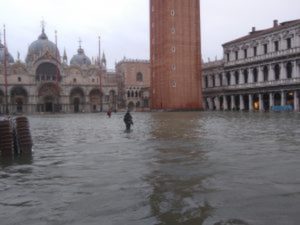Italy has fifty-eight UNESCO World Heritage Sites, ranging from ancient rock drawings up north in Valcamonica to the Cathedral of Cefalù down south in Sicily. However, never before has a UNESCO-listed site in Italy been placed on the organization’s list of World Heritage in Danger. Those sites are typically in countries embroiled in civil wars or other conflicts, like Syria, Ukraine, Libya, Yemen, and the Democratic Republic of the Congo. But in Italy, the entire city of Venice might be their first site on the list. The whole city and its surrounding lagoon have been a UNESCO World Heritage Site since 1987. Many cities, in full or in part, have received the same designation, including Damascus, Jerusalem, Santo Domingo, and Salzburg. Venice is not even the only city in Italy to gain this classification, as others like Rome, Florence, Naples, Genoa, Siena, Syracuse, and Verona all have some form of UNESCO protection. I’ve written previously about efforts to salvage Venetian cultural heritage through restoration and new research. While this work is important, it won’t mean much if there isn’t even a city left.
Venice has been a popular tourist spot since the eighteenth century when it became a stop on the Grand Tour, a trip to many of Europe’s major cities that young, educated men would take some time in their late teens or early twenties. Nowadays, around 60,000 tourists can be found daily in the city’s historic center, just shy of matching the number of permanent residents. The greater number of tourists has endangered the city in several ways. Cruise ships are one of the biggest targets some activists and politicians have placed in their crosshairs. There have been several attempts to ban large vessels from the Venetian lagoon since they are often unwieldy and cause damage to docks, piers, and buildings. They also displace enormous amounts of water, which leads to the erosion of building foundations. Lastly, they drag in large quantities of sediment from the Adriatic Sea and the lagoon, which local authorities must dredge out of the city canals. Tourists traveling on large cruise ships tend to eat and sleep on their boats, meaning that despite daytrippers and cruise ship passengers making up close to three-quarters of the city’s tourists, they do very little for the local economy since they’re not staying in hotels or patronizing local restaurants. The most recent attempt to ban large ships came in 2021 following pressure from UNESCO. However, cruise ships were still docking close to the city center since local authorities did not build suitable docks outside the lagoon.
Climate change also threatens Venice’s existence. Apart from Carnival, one of the most famous annual events in Venice is when water rushes into the lagoon from the Adriatic Sea and floods the historic city center in what is commonly known as the acqua alta. Normally, the acqua alta took place once a year at most. However, with the current climate crisis, the city has been flooding more and more frequently. Of the most severe floods Venice has endured over the past hundred years, five of the top ten have occurred since 2018. The worst came on November 12, 2019, when the waters rose 187 centimeters (74 inches) above sea level, submerging around 80% of the city center. Unfortunately, one of the city’s most iconic cultural heritage sites, St. Mark’s Basilica and its adjacent square, sits on its lowest point at 64 centimeters (25 inches) above sea level, meaning the historic site is particularly vulnerable to water damage. Efforts to prevent more frequent flooding have been underway for about twenty years. In 2003, Silvio Berlusconi oversaw the start of the Experimental Electromechanical Module project, commonly known as MOSE. The project seeks to build a series of gates across the three inlets connecting the lagoon to the Adriatic Sea, which will close should the water be predicted to rise above 110 centimeters. The MOSE project is expected to be completed in late 2023, way behind schedule because of the horrendous corruption that plagued the project. The flooding will only worsen, especially because Venice is sinking as well. This is partially due to phenomena beyond human control, namely shifts in the Adriatic tectonic plate. However, experts have identified some contributing causes that can be remedied. In the 1960s, the local government banned the use of artesian wells after discovering that their use drew water from the aquifer and contributed to the sinking. Even with the measures already taken, Venice continues to sink about 1 to 2 millimeters per year.
Should sea levels continue rising and the city continues subsiding, many of Venice’s cultural institutions and the art they contain may be compromised. Though the historic city center is rather small, it is chock full of priceless art. The Ca’ Rezzonico, for example, is one of the city’s best examples of baroque Venetian architecture and contains one of Europe’s finest collections of eighteenth-century art. Works by Canaletto, Tintoretto, Francesco Guardi, and Rosalba Carriera populate the galleries, sometimes accompanied by the palace’s original frescoes by Giambattista Tiepolo. The Peggy Guggenheim Collection, just a ten-minute ride in a water taxi down the Grand Canal, is an impressive assembly of modern masterworks by Joan Mitchell, Piet Mondrian, Leonora Carrington, Jackson Pollock, and Marcel Duchamp. Perhaps the best-known pieces in the collection are Picasso’s cubist work The Poet, one of Magritte’s L’Empire des Lumières paintings, and a bronze casting of Constantin Brâncuși’s Bird in Space. Then, situated halfway between the antique and the modern, the Galerie dell’Accademia showcases Venetian art throughout the centuries, including works by Giovanni Bellini, Titian, and Paolo Veronese. But the museum’s main attraction is by one of the few non-Venetian artists represented in the galleries: Leonardo da Vinci’s Vitruvian Man. Of course, these are just some of the museums. I haven’t even mentioned the dozens of churches, palaces, bell towers, and bridges that will be endangered as well.
UNESCO’s World Heritage Committee will meet later this September in Riyadh to decide if Venice should be considered in danger. Some have been hoping this news will provoke action, like enacting policies to help prevent Venice from being affected by rising sea levels, subsidence, and over-tourism. However, the local, regional, and national governments have done little to face these problems for decades. Veneto, the region of which Venice is the capital, tends to vote more conservatively than the rest of Italy, meaning regional authorities are hesitant to tackle climate change. Ironically, in November 2019, the Veneto Regional Council, which meets in the Palazzo Ferro Fini on the Grand Canal, voted down policies that would combat climate change, and then 2 minutes later, the building began to flood. Massimo Cacciari, former mayor of Venice, was rather pessimistic and had some unkind words for UNESCO: “They don’t give us any funding to make changes, all they do is criticize… As if Venice needed Unesco to be a world heritage site! We need more action and fewer words.” Though harsh, Cacciari’s words ring true. Even if UNESCO places Venice on this other list, that by itself won’t make any changes to helping the city survive. So hopefully the right people will take this as a wakeup call.


